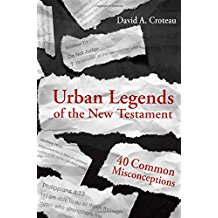Urban Legends of the New Testament: 40 Common Misconceptions David A. Croteau
- Approximate Time Commitment: 10 minutes
URBAN LEGENDS OF THE NEW TESTAMENT: 40 Common Misconceptions was written by David A. Croteau. This review was written by Hank Griffith of South Suburban Evangelical Free Church in Apple Valley, Minnesota. This book is good for all believers to understand the New Testament and what are some common misconceptions.
Resource Description
Full Review:
Here’s a delightful new book – easy to read, yet well researched. The author, Dr. David A. Croteau, is professor of New Testament and Greek in the Seminary and School of Ministry at Columbia International University in Columbia, SC. Croteau’s goal is to show how a number of well-known passages in the New Testament are regularly misinterpreted, and these misinterpretation are passed on from pastor to pastor, Christian to Christian, sometimes for generations.
Perhaps more important than pointing out “the legend”, Croteau reveals the true meaning of each of the passages by using proper rules of biblical interpretation. He then goes on to apply each of the texts to our lives. What a great book to use as a supplement to a hermeneutics textbook in a class at a Christian college or seminary, or simply as the basis of study in an adult Sunday School class!
The misinterpretation of certain verses has become like an urban legend. We hear it, but we never bother to verify if it’s true. For example, how many times have you heard it said that in Mathew 19:24 (“Again I tell you, it is easier for a camel to go through the eye of a needle than for someone who is rich to enter the kingdom of God.”) Jesus is referring to a low gate for camels in the wall of Jerusalem? The problem is there’s zero historical evidence that such a gate ever existed. Instead this is likely an example of Jesus using hyperbole, as He often does, to teach that salvation is impossible for a rich man, or anybody for that matter, apart from the sovereign work of God.
Croteau emphasizes that the most common reason most passages are interpreted incorrectly is the failure to study it in its literary context. Context is important because it forces the interpreter to examine the biblical writer’s overall flow of thought. The meaning of any passage is nearly always determined, controlled, or limited by what appears immediately beforehand and afterward in the text, as well as the book as a whole.
Another reason certain passages are interpreted incorrectly is that most of us pastors have studied just enough Greek to be dangerous, but not enough to really use the language as a useful tool. This can be illustrated by an interpretation of the Great Commission in Matthew 28:19-20 that I’ve heard in past years. Speakers, especially those who are teaching on disciple-making, point out that there is only one imperative in the passage (“make disciples”). The verb “go” is a participle and should be translated, “As we go” or “When we go”. Croteau disagrees. “Go” is indeed a participle, but a participle in certain contexts should be translated as a command. Matthew often uses the participle “go” that way in his gospel. This same construction and the same actual verb “go” is found in other verses in Matthew, and it’s always translated as a command:
- Matt 2.8: “Go and look carefully for the child.”
- Matt 9.13: “Go and learn what this means.”
- Matt 11.4: “Go and tell John what you hear and see.”
- Matt 17.27: “Go to the lake and throw out a hook”
- Matt 28.7: “Go quickly and tell his disciples”
The reason this misinterpretation matters is that to eliminate the command to GO to the nations can kill the missionary emphasis of this important verse.
Still another reason for poor biblical interpretation is a failure to really understand the background of a passage. This can best be done for most of us who are not New Testament scholars by referring to a book like Zondervan Illustrated Bible Backgrounds Commentary, a five volume set written by a number of evangelical scholars a few years ago. It’s pricey, but extremely useful. Croteau writes, “The principle I apply for using background information is this: when in doubt over whether the information is relevant to the text being interpreted, use caution. I virtually always endeavor to verify the background information myself.’
I’d like to close with something you have heard many well-meaning Christians say when giving their testimony: “I asked Jesus into my heart on … .” Unfortunately, in saying this they make no mention whatsoever of having repented or put their faith in Christ for salvation, though maybe they have. This unfortunate wording may be partially due to the old hymn “Since Jesus Came Into My Heart”. More likely though it’s because of a misinterpretation of Revelation 3:20, “Behold, I stand at the door and knock. If anyone hears my voice and opens the door, I will come in to him and eat with him, and he with me.” Does this verse have anything at all to say about how to be saved? I don’t think so. After undertaking a thorough study of the verse in its context Croteau concludes that Revelation 3:20 refers to the offer of fellowship with the living Christ once believers in the church of Laodicea have repented of their lack of zeal.
Hopefully this short review has given you enough information about a few well-known urban legends of the New Testament to make you want to dig deeper. I have only touched the surface of David Croteau’s solid interpretations and applications of forty New Testament legends.
Only logged in customers who have purchased this product may leave a review.



Reviews
There are no reviews yet.